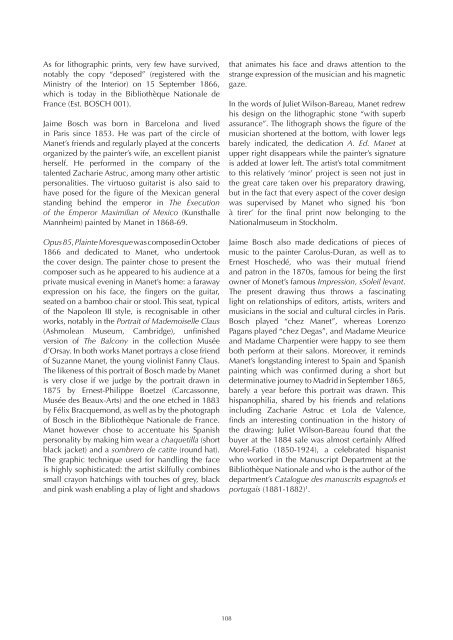XV - Works On Paper - Marty de Cambiaire (English)
You also want an ePaper? Increase the reach of your titles
YUMPU automatically turns print PDFs into web optimized ePapers that Google loves.
As for lithographic prints, very few have survived,<br />
notably the copy “<strong>de</strong>posed” (registered with the<br />
Ministry of the Interior) on 15 September 1866,<br />
which is today in the Bibliothèque Nationale <strong>de</strong><br />
France (Est. BOSCH 001).<br />
Jaime Bosch was born in Barcelona and lived<br />
in Paris since 1853. He was part of the circle of<br />
Manet’s friends and regularly played at the concerts<br />
organized by the painter’s wife, an excellent pianist<br />
herself. He performed in the company of the<br />
talented Zacharie Astruc, among many other artistic<br />
personalities. The virtuoso guitarist is also said to<br />
have posed for the figure of the Mexican general<br />
standing behind the emperor in The Execution<br />
of the Emperor Maximilian of Mexico (Kunsthalle<br />
Mannheim) painted by Manet in 1868-69.<br />
Opus 85, Plainte Moresque was composed in October<br />
1866 and <strong>de</strong>dicated to Manet, who un<strong>de</strong>rtook<br />
the cover <strong>de</strong>sign. The painter chose to present the<br />
composer such as he appeared to his audience at a<br />
private musical evening in Manet’s home: a faraway<br />
expression on his face, the fingers on the guitar,<br />
seated on a bamboo chair or stool. This seat, typical<br />
of the Napoleon III style, is recognisable in other<br />
works, notably in the Portrait of Ma<strong>de</strong>moiselle Claus<br />
(Ashmolean Museum, Cambridge), unfinished<br />
version of The Balcony in the collection Musée<br />
d’Orsay. In both works Manet portrays a close friend<br />
of Suzanne Manet, the young violinist Fanny Claus.<br />
The likeness of this portrait of Bosch ma<strong>de</strong> by Manet<br />
is very close if we judge by the portrait drawn in<br />
1875 by Ernest-Philippe Boetzel (Carcassonne,<br />
Musée <strong>de</strong>s Beaux-Arts) and the one etched in 1883<br />
by Félix Bracquemond, as well as by the photograph<br />
of Bosch in the Bibliothèque Nationale <strong>de</strong> France.<br />
Manet however chose to accentuate his Spanish<br />
personality by making him wear a chaquetilla (short<br />
black jacket) and a sombrero <strong>de</strong> catite (round hat).<br />
The graphic technique used for handling the face<br />
is highly sophisticated: the artist skilfully combines<br />
small crayon hatchings with touches of grey, black<br />
and pink wash enabling a play of light and shadows<br />
that animates his face and draws attention to the<br />
strange expression of the musician and his magnetic<br />
gaze.<br />
In the words of Juliet Wilson-Bareau, Manet redrew<br />
his <strong>de</strong>sign on the lithographic stone “with superb<br />
assurance”. The lithograph shows the figure of the<br />
musician shortened at the bottom, with lower legs<br />
barely indicated, the <strong>de</strong>dication A. Ed. Manet at<br />
upper right disappears while the painter’s signature<br />
is ad<strong>de</strong>d at lower left. The artist’s total commitment<br />
to this relatively ‘minor’ project is seen not just in<br />
the great care taken over his preparatory drawing,<br />
but in the fact that every aspect of the cover <strong>de</strong>sign<br />
was supervised by Manet who signed his ‘bon<br />
à tirer’ for the final print now belonging to the<br />
Nationalmuseum in Stockholm.<br />
Jaime Bosch also ma<strong>de</strong> <strong>de</strong>dications of pieces of<br />
music to the painter Carolus-Duran, as well as to<br />
Ernest Hoschedé, who was their mutual friend<br />
and patron in the 1870s, famous for being the first<br />
owner of Monet’s famous Impression, sSoleil levant.<br />
The present drawing thus throws a fascinating<br />
light on relationships of editors, artists, writers and<br />
musicians in the social and cultural circles in Paris.<br />
Bosch played “chez Manet”, whereas Lorenzo<br />
Pagans played “chez Degas”, and Madame Meurice<br />
and Madame Charpentier were happy to see them<br />
both perform at their salons. Moreover, it reminds<br />
Manet’s longstanding interest to Spain and Spanish<br />
painting which was confirmed during a short but<br />
<strong>de</strong>terminative journey to Madrid in September 1865,<br />
barely a year before this portrait was drawn. This<br />
hispanophilia, shared by his friends and relations<br />
including Zacharie Astruc et Lola <strong>de</strong> Valence,<br />
finds an interesting continuation in the history of<br />
the drawing: Juliet Wilson-Bareau found that the<br />
buyer at the 1884 sale was almost certainly Alfred<br />
Morel-Fatio (1850-1924), a celebrated hispanist<br />
who worked in the Manuscript Department at the<br />
Bibliothèque Nationale and who is the author of the<br />
<strong>de</strong>partment’s Catalogue <strong>de</strong>s manuscrits espagnols et<br />
portugais (1881-1882) 1 .<br />
108
















